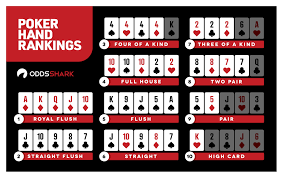Poker is a collection of card games that involves beating competition through a combination of cards. It also includes betting in between so as to maximize the returns as well as minimize the risk of losing. The rankings are precisely calculated, based on the strength of the cards in a player’s hand. Essential things to be considered include the rank of the card, suit as well as number of cards in a player’s hand.
The best place to start to gain an understanding of poker hands is to know the rank properly. It is defined as the arrangement of the cards in a player’s hand, from lowest to highest: 2, 3, 4, 5, 6, 7, 8, 9, 10, Jack, Queen, King. However, it is also important to know the rank of the card in that as well. For instance, four aces rank higher than two two’s, three three three’s rank higher than four four’s, five five’s rank higher than six six’s and so on. In poker, cards are also divided into two categories, face cards and other cards.
Poker rooms absolutely love players that know the cards in advance. This allows them to manipulate the game in their favor. For instance, they can manipulate the shuffle toavourites to a certain extent and increase the house advantage. Moreover, knowing the cards allows the player to guess if the next card on the table has a good match to the number in the player’s hand.
In poker, when a card is dealt face up, it is referred to as the flop. The next card, whether it is single or a pair, is referred to as the turn. In the final stage, the card is referred to as the river. In old poker, players try to make the combination of cards in their hand to complete the exceptionally high set of cards.
The individual cards are also important. In poker, a pair is stronger than three of a kind, two pairs are stronger than three of a kind, and if three of a kind is stronger than two of a kind, then a high card is stronger than anything.
It is important to know all the possible combinations to make a hand. This will increase the probability of the player to guess the whole sequence of cards in the receiving hands. E.g. If a player receives 3 Queens and 2 tens, then the odds are 3/2 or about 1:1, which is not favorable. If a player receives 7 sevens and 3 tens, the odds are 6/5 or about 1:1, which again is not favorable. However, if a player receives K,Q,J,10,9,8,7,6,5,4,3,2 then the odds are 2/1 or about 34% for this event. The portion for the high cards is especially important because a player cannot hope to have both high cards in the same order.
Odds also apply to the number of cards in a player’s hand. If a player has more cards than the number of cards in his hand, the hand will be characterized as a loose hand. In contrast, a loose hand when fewer cards are received with the goal of forming a good hand. This is best described as being in the range of twenty-five to fifty cards.
Odds can be calculated by solving the series of equations in terms of probabilities. For instance, the number of cards taken by a player should be included in the number of cards released, the number of cards left in the deck, the number of cards in a certain vertical column, and the sum of all the cards.
Today, online MPO500 sites enable the calculation of these odds in an easy and efficient manner. The hard part is telling the player how many cards remain in the deck and where the deck starts. Some of the techniques can be automated using Microsoft Excel. You just have to create a text file in Excel and a formula to automate the task. When you run the formula, you just need to copy and paste the formula anywhere in the text file to perform the task.
Some of the best places to find the odds are in the cell above your original bet. You can find two different odds, the payout for one card and the payout for the next card, in one of the cells. Just remember that you are not guaranteed to win every hand. If you’d like some more tips on Hold’em odds, we recommend purchasing our beginners guide, How to Play Texas Hold ‘Em, which has 37 comprehensive tables of the most important statistics. Our website has a free version of the guide, packed with our selections.
